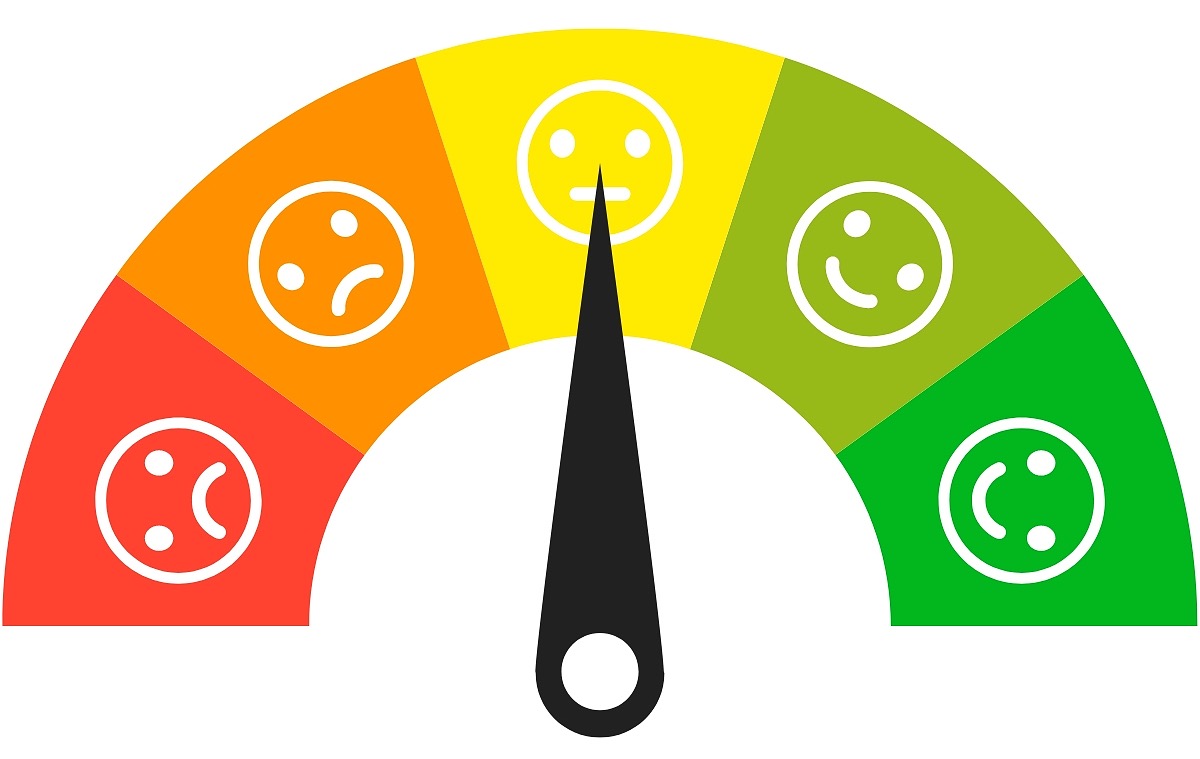 https://www.mypinio.com/wp-content/uploads/2023/02/How-to-find-promo-codes-easily.jpg
788
1400
mypinio
https://mypinio.com/wp-content/uploads/2022/04/mypinio_logo-1.png
mypinio2023-02-13 12:03:402023-02-13 12:06:15Promo Code: This is how easy you can find them to save money
https://www.mypinio.com/wp-content/uploads/2023/02/How-to-find-promo-codes-easily.jpg
788
1400
mypinio
https://mypinio.com/wp-content/uploads/2022/04/mypinio_logo-1.png
mypinio2023-02-13 12:03:402023-02-13 12:06:15Promo Code: This is how easy you can find them to save moneyCONTENT
- 1 What is a Likert scale, what is a Likert test? A definition.
- 2 Example of a Likert scale
- 3 Forms of presentation of a Likert scale
- 4 How is the Likert scale question type or a Likert test analysed?
- 5 What are the main advantages of the Likert scale?
- 6 What are the disadvantages of the Likert scale?
- 7 Tips from experts: How to avoid mistakes when using the Likert test!
What is a Likert scale, what is a Likert test? A definition.
Likert scale
The Likert scale is an important tool in psychology and market research to measure people’s attitudes and opinions about certain topics or objects. It was named after the American psychologist Rensis Likert and was first used in 1932.
The Likert scale consists of a series of statements called “items” that a person can disagree or agree with. The statements are graded and polarising, meaning that they ask the person’s opinion in different directions. For example, one item might read, “I fully agree with the statement that cars should be taxed more,” while another item might read, “I disagree with the statement that cars should be taxed more.”
Likert test
The use of Likert scales in a questionnaire is called a Likert test. In a Likert test, a person is presented with several questions and asked to indicate their attitude towards each of them by indicating how much they agree with the statement on a scale from “strongly disagree” to “strongly agree”. The scale may also contain several intermediate levels, such as “partial agreement” or “neutral”.
The results of the test are then evaluated to measure the person’s attitude towards the topic or object. The Likert scale is a very common and effective method of measuring people’s opinions and attitudes because it is easy to understand and use and is well suited for quantitative statistical analysis. It is often used in market research, social psychology and other fields where the aim is to record and analyse people’s opinions and attitudes.
Example of a Likert scale
Here is an example of a Likert scale that could be used to measure customer satisfaction with a particular product or service:
I am not at all satisfied with the product/service.
I am rather dissatisfied with the product/service.
I am neutral about my satisfaction with the product/service.
I am rather satisfied with the product/service.
I am completely satisfied with the product/service.
The person completing the Likert test would then indicate how much they agree with each statement on a scale of 1 to 5. The results of the test would then be evaluated to measure the person’s satisfaction with the product or service.
The Likert scale would then look like this:
Question: How satisfied are you with our products?
| 1 | 2 | 3 | 4 | 5 | ||
| very unhappy | X | very happy |
The Likert scale can also be presented very simply, like this:
How satisfied are you with our products?
not at all [1] [2] [3] [4] [5] very much
The Likert scale can have any number of items or options. However, it usually contains between five and seven options, graded from ‘strongly disagree’ to ‘strongly agree’. However, there are also Likert scales with more or fewer options, depending on which attitudes or opinions are to be measured.
Forms of presentation of a Likert scale
The Likert scale is typically presented as a line, bar or tick option indicating the different response options, such as in the example above. The response options are usually graded from ‘strongly disagree’ to ‘strongly agree’, although there are other options such as ‘very unlikely’ to ‘very likely’. The person chooses the response option that best reflects their attitude towards the statement.
The Likert scale can be represented in many other ways, including graphically, for example in the form of emojis. Below are some examples of ways to display a Likert scale.
Likert scale with emojis
It is possible to display the Likert scale with emojis. Emojis are small graphics used in digital messages and other online content to express feelings, moods or ideas. They can also be used to represent response options in a Likert scale.
To represent the Likert scale with emojis, the emojis are displayed next to each answer option. The person completing the questionnaire chooses the emoji that best reflects their attitude towards the statement.
Here is an example of a Likert scale with emojis:
Question: How satisfied are you with the customer service you have received?

The person completing the questionnaire would then choose the emoji that best reflects their satisfaction with customer service. The results of the questionnaire would then be analysed to measure customers’ overall satisfaction with customer service.

The way a Likert scale is presented in a Likert test can be made very variable. Graphics can make a questionnaire more attractive so that survey participants are more willing to take part in a Likert test.
Likert scale as matrix question in a likert test
A Likert scale can also be presented as a matrix question. A matrix question is a form of question in which several items are arranged in a table or grid, and the person completing the questionnaire is asked to indicate their attitude towards each item.
To present a Likert scale within a Likert test as a matrix question, the items are arranged in a table and a scale with the answer options is displayed next to each item. The person completing the questionnaire selects the response option that best reflects their attitude towards the item.
| fully disagree | disagree | neutral | agree | fully agree | |
| Cars should be taxed higher | X | ||||
| Petrol should become much more expensive | X | ||||
| The purchase of a bicycle should be subsidised | X | ||||
| Rail tickets should become much cheaper | X |
How is the Likert scale question type or a Likert test analysed?
To analyse a Likert scale or a Likert test, the answers to each question are usually added up and divided by the number of answers to get the mean value of the answers. This mean is then used to interpret people’s attitudes or opinions.
An example of a simple Likert test
Let’s say you are conducting a survey on employee satisfaction in your company. The questionnaire for measuring employee satisfaction also contains, among other things, a “Likert scale” question type with five possible response options.
Ο I am very satisfied with my current job.
Ο I am satisfied with my current job.
Ο I am somewhat satisfied with my current job.
Ο I am dissatisfied with my current job.
Ο I am very dissatisfied with my current job.
Suppose you sent the above test with five response options to 1000 subjects and collected the responses as follows:
- Answer 1: 150 subjects
- Answer 2: 250 respondents
- Answer 3: 300 respondents
- Answer 4: 150 respondents
- Answer 5: 150 respondents
To calculate the mean, sum the values of all answers and divide the result by the number of subjects who took the test (1000).
(1501 + 2502 + 3003 + 1504 + 150*5) / 1000 = 2.8
The mean value of 2.8 means that the opinion of the test persons is overall rather “somewhat satisfied”.
Besides this simple method, there are many other ways to analyse the data of a Likert test or a likert scale question type, depending on the purpose and nature of the test. For example, you can visualise the distribution of responses to see the frequency of each response option. This can be useful to see if there are significant differences between different groups of subjects. Or to contrast the significance of different groups. Or you can also calculate the standard deviation to quantify the spread of responses.
What are the main advantages of the Likert scale?
The Likert scale is a simple and reliable way to quantitatively measure opinions and attitudes, which is why it is used in many areas of social research. It has some important advantages, including:
- Ease of use: The Likert scale is easy to understand and use because it consists of a series of statements that participants can rate on a scale of 1 to 5 (or 1 to 7).
- High reliability: The Likert scale usually has high test-retest reliability, which means that it provides reliable results when used at different time points.
- Good validity: The Likert scale usually has good construct validity, which means that it measures what it claims to measure.
- Flexibility: The Likert scale can be easily adapted to the needs of a study by adding or removing different statements or by lengthening or shortening the scale.
- Comparability: The Likert scale makes it possible to compare the results with those of other studies, as it is a widely used measurement tool and the scale has a similar structure.
- Quick evaluation: The Likert scale makes it possible to evaluate the results quickly, as the answers are given on a scale of 1 to 5 (or 1 to 7) and can thus be easily transferred to a table or chart.
- Reduction of bias: The Likert scale can help reduce bias in responses as it gives participants a wide range of options to express their opinion rather than just asking “yes” or “no”.
- Ability to use averages: The Likert scale allows averages to be calculated to aggregate and compare results. This can be useful to identify trends or changes in responses over time.
- Suitability for different purposes: The Likert scale can be used for different purposes, such as recording attitudes, opinions, satisfaction, knowledge or behavioural intentions.
- Availability of norms: For many Likert scales, norms already exist that allow the results to be compared with a reference group. This can be useful to put the results of one’s own study into a wider context.
- Possibility to use medians: As already mentioned, Likert scale results can be evaluated using mean values. However, it is also possible to calculate medians in order to aggregate and compare the results. This can be useful if the data distribution is not normal or if there are outliers in the data.
- Possibility to use modal values: It is also possible to calculate modal values (i.e. the most frequent answer) to aggregate and compare the results. This can be useful when there are no clear trends in the data or when participants do not have a clear opinion.

One reason why the Likert scale is so popular in market research and social science is that it is relatively easy to understand and interpret. The results can be evaluated in the form of means or medians, which make statements about the opinions or attitudes of the participants.
What are the disadvantages of the Likert scale?
Like any measurement tool, the Likert scale has some disadvantages. It is important to consider these disadvantages when using the Likert scale and, if necessary, take steps to minimise them to ensure that the results are valid and reliable. The following are important disadvantages of using the Likert scale or a Likert test:
- Limited response options: The Likert scale offers limited response options, restricted to a scale of 1 to 5 (or 1 to 7). This may result in the opinions of participants not being fully represented.
- Possible bias due to comprehension problems: If the statements in the scale are not clearly worded or if participants have difficulty understanding them, the results may be biased.
- Possible bias due to socially desirable responses: The Likert scale may tend to produce socially desirable responses if participants tend to adjust their answers according to others’ expectations or their own values.
- Limited flexibility: While the Likert scale is flexible in that it can be easily adapted to the needs of a study, it is still limited by the fact that it is based on a scale of 1 to 5 (or 1 to 7).
- Possible bias due to ambivalence: If participants are ambivalent, i.e. could both agree and disagree, the results may be biased as the scale does not provide a way to express this ambivalence.
Limited applicability: The Likert scale is best suited for capturing opinions, attitudes and behavioural intentions, but it is less suitable for capturing complex concepts or for capturing behaviours or concrete actions. - Possible bias due to extremes: If there are extreme options in the scale (e.g. “strongly agree” and “strongly disagree”), the results may be biased because participants may tend to choose these options even if they do not fully agree with them.
- Possible bias due to confounding: The Likert scale may also tend to produce confounding in responses if participants tend to adjust their answers according to the expectations of the study administration or their own values.
- Possible bias due to confusion between opinions and facts: If the statements in the scale mix opinions and facts, the results may be biased because participants may not always be able to distinguish between opinions and facts.
- Possible bias due to intentions and behaviours: The Likert scale is good for capturing intentions, but it is less suitable for capturing actual behaviours, as participants may not always put their intentions into action.
Tips from experts: How to avoid mistakes when using the Likert test!
It is important to consider the disadvantages described above when using the Likert scale or a Likert test and, if necessary, take steps to minimise them to ensure that the results are valid and reliable. To avoid mistakes when using the Likert scale, the following steps can be followed:
- Formulate clear and precise statements: It is important that the statements used in the scale are worded clearly and precisely so that participants can easily understand them and express their opinions accordingly.
- Use an adequate number of options: It is important to have a sufficient number of options in the scale to reflect participants’ opinions, but not so many that it becomes difficult to make the right choice.
- Use a balanced scale: It is important that the scale is balanced, i.e. that there are equal numbers of options to agree and disagree. Otherwise, the results could be skewed.
- Provide a neutral option: It is important to provide a neutral option in the scale to allow participants to indicate when they neither agree nor disagree. Otherwise, the results could be biased.
- Minimise socially desirable responses: It is important to minimise the possibility of socially desirable responses by ensuring anonymity of participants or by ensuring that statements in the scale are worded neutrally.
- Avoid extreme options: It is important to avoid extreme options in the scale as these tend to produce biased results. Medium options should be used instead.
- Avoid confusing opinions and facts: It is important to neatly separate opinions and facts in the scale to ensure that participants can express their opinions appropriately.
- Separate intentions and behaviours: When it comes to capturing intentions and behaviours, it is important to separate them cleanly and use appropriate measurement tools.
- Check the distribution of data: It is important to check the distribution of the data to ensure that it is normal. If the distribution is not normal, mean values may be skewed and it may be more appropriate to use medians or modal values.
- Check outliers: It is important to check for outliers in the data and, if necessary, ignore or explain them as they can skew the results.
- Check reliability: It is important to check the reliability of the Likert scale to ensure that it gives reliable results. This can be done using Cronbach’s alpha or other appropriate measurement methods.
- Check validity: It is also important to check the validity of the Likert scale to ensure that it actually measures what it is designed to measure. This can be done using criterion validity or other appropriate measurement methods.
- Check applicability: It is important to check the applicability of the Likert scale to ensure that it is appropriate for the intended study and that it adequately reflects participants’ opinions or attitudes. If the Likert scale is not appropriate for the planned study, another measurement tool should be considered.
- Check the representativeness of the sample: It is important to ensure that the sample used for the study is representative of the whole population so that the results can be generalised to the whole population.
- Check the randomness of the sample: It is also important to ensure that the sample used for the study is randomly selected to ensure that the results are not biased.
read also
#marketresearch #maxdiff #netpromoterscore #semanticdifferential #insightscommunity
[shariff]
Keywords of this blog post
Likert scale | definition | how to use | tipps | advantages



